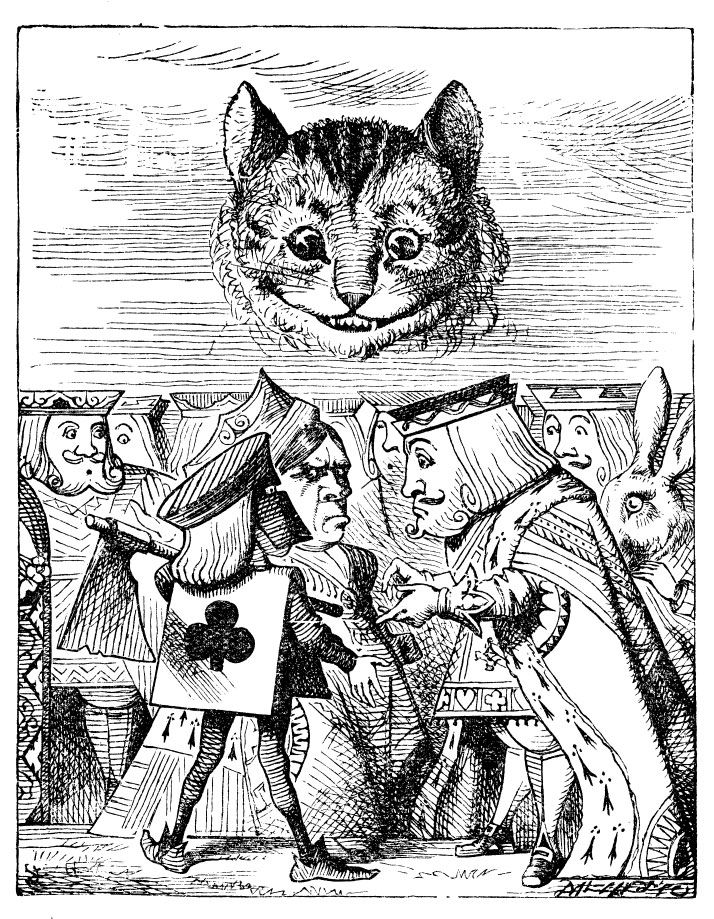
Friday
I see that Washington Post satirist Alexandra Petri has pulled a Better Living through Beowulf maneuver and applied a literary work to Donald Trump. In this case, Alice’s Adventures in Wonderland.
Actually, the idea traces back to Jared Kushner, presidential advisor and son-in-law, who according to Bob Woodward said the works helps explain the president. According to a Washington Post article,
[Bob] Woodward writes that [Jared] Kushner advised people that one of the most important guiding texts to understand the Trump presidency was Alice in Wonderland, a novel about a young girl who falls through a rabbit hole. He singled out the Cheshire cat, whose strategy was endurance and persistence, not direction.
The Cheshire Cat hardly seems a model of endurance and persistence. But I’ll circle back to Cheshire Cat comparisons in a moment. Let’s first look at Petri’s other parallels.
Petri says that comparing the Trump administration to the story of a girl who falls down a rabbit hole and finds herself in “a nonsensical world full of hallucinogens” is tantamount to saying that Down and Out in Las Vegas and Dante’s Inferno are also applicable. I can testify that she’s right in the latter instance as I have written a number of posts applying Inferno (and Lewis Carroll as well) to the Trump administration. In other words, Petri finds parallels that probably did not occur to Kushner.
For instance, she says that suddenly-tall-Alice’s thought about mailing letters to her feet would have had to occur early in the Trump administration, when we still had a well-functioning post office. She also observes that Alice asking for advice from a drug-smoking caterpillar and receiving, in return, reality-altering mushrooms is like Trump getting advice from those around him— “except that none of them needs the aid of mushrooms to alter reality at any moment.”
Then there’s the mad tea party and the croquet game:
She has tea with the March Hare, the Mad Hatter and a dormouse who keeps falling asleep into his soup. I think this is supposed to give the impression of what it is like to attend a Cabinet meeting. The dormouse, I am absolutely certain, is Wilbur Ross. Given that the Mad Hatter is prone to wearing a hat with a message on it and being mad, he stands in for the ardent Trump supporter.
After tea, Alice winds up playing croquet with the Queen of Hearts, who keeps shouting, “Off with their heads!” at various parties; she uses a flamingo as a mallet and a hedgehog as a ball. I think this shows how the Trump administration approaches the use of government: There are tools designed for certain purposes that people have honed over a long time, but instead of even attempting to use them, you should seize a wild bird and bludgeon it repeatedly. It is good if everyone around you is terrified, at all times, of being beheaded. This is leadership.
The trial that concludes the book reminds Petri of Republicans at the impeachment hearing:
The triumph of loud illogic during this trial is an almost eerily exact replica of the Republican questions during the impeachment hearing, a chain of random non sequiturs presented as damning indictments! Did you know that not having done something incriminating proves that you are a guilty party, and vice versa? This section was uncanny! Anyway, off with everyone’s head!
In the Cheshire Cat, Petri sees someone who doesn’t make much sense and smiles endlessly. In other words, the vice-president:
Later, Alice encounters the Cheshire Cat, apparently the embodiment of the best leadership philosophy you can have in the Trump administration. Alice asks the cat which way she ought to go; the cat asks where she is trying to get to, and she says she doesn’t care. The cat responds that it doesn’t matter, in that case, which way she goes. It then smiles, says several more things that do not make any sense and vanishes. This is most likely Mike Pence.
I disagree here in that the cat is much more of an independent thinker than Pence and isn’t afraid to confront royalty, prompting the queen to order his beheading. He is like Trump, however, in his ability to evade any repercussions for his behavior. Consider the following scene, in which the cat’s disembodied head hovers over the croquet game:
When [Alice] got back to the Cheshire Cat, she was surprised to find quite a large crowd collected round it: there was a dispute going on between the executioner, the King, and the Queen, who were all talking at once, while all the rest were quite silent, and looked very uncomfortable….
The executioner’s argument was, that you couldn’t cut off a head unless there was a body to cut it off from: that he had never had to do such a thing before, and he wasn’t going to begin at his time of life.
The King’s argument was, that anything that had a head could be beheaded, and that you weren’t to talk nonsense.
The Queen’s argument was, that if something wasn’t done about it in less than no time she’d have everybody executed, all round. (It was this last remark that had made the whole party look so grave and anxious.)
The debate becomes moot when the cat fades away. The idea of Trump quietly fading way is a consummation devoutly to be wished. And also no less fantastical than Carroll’s book.
Previous posts applying Lewis Carroll to Donald Trump
Hopefully, Trump Is the Queen of Hearts
Lewis Carroll Has Trump’s Number
GOP’s Best Case: We’re All Mad
Following Attorney General Barr Down the Rabbit Hole
Trump’s Latest Queen of Hearts Beheading
Is Trump Running a Red Queen Race?
Lewis Carroll Describes the Caucus Races
Trump and Dante’s Inferno
Trump and Inferno’s Nine Circles – Pick One
Dante Weighs In on Trumpian Sins